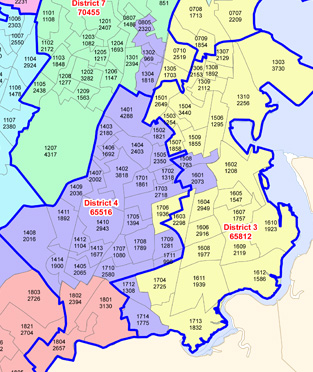October 18, 2012
The City Council’s agonizing redistricting process drags on this week as it weighs several competing maps that would redraw the lines of the district seats in time for next year’s election. District 4, which covers parts of both Mattapan and Dorchester, has become the main focus because two mayoral vetoes of earlier maps passed by the council specifically cited the “packing” of too many voters of color into the district. In fact, in both instances, it was the only issue highlighted by the mayor as the reason for his blocking the maps passed by the council by close margins in each case.
 Council district shuffle: One of several proposed maps in play. District 4 has been represented since its creation in 1983 by just one person: Councillor Charles Yancey. Yancey has been a strong advocate for Mattapan through the years, even though he doesn’t live there; he lives in the Melville Park section of Dorchester, far closer to Fields Corner than Mattapan Square. That fact makes Yancey’s mandate that his colleagues “re-unite Mattapan” — while keeping him in the seat that covers it— a near-impossible task. His own attempt at creating such a map accomplishes the feat, but does so in part by forcing two of his current colleagues— Tito Jackson and Mike Ross—into one district, a scenario that is a non-starter politically.
Council district shuffle: One of several proposed maps in play. District 4 has been represented since its creation in 1983 by just one person: Councillor Charles Yancey. Yancey has been a strong advocate for Mattapan through the years, even though he doesn’t live there; he lives in the Melville Park section of Dorchester, far closer to Fields Corner than Mattapan Square. That fact makes Yancey’s mandate that his colleagues “re-unite Mattapan” — while keeping him in the seat that covers it— a near-impossible task. His own attempt at creating such a map accomplishes the feat, but does so in part by forcing two of his current colleagues— Tito Jackson and Mike Ross—into one district, a scenario that is a non-starter politically.
Whether Mattapan— or any other city neighborhood— is covered by a single councillor or two, or even three, is secondary to the more pressing goal of empowering voters, particularly voters of color. Boston has been a majority-minority city for at least two decades now. The districts should be drawn in such a way that voters of color have an increased opportunity to flex their voting power in more districts, and not drawn to condense —or pack— their numbers into super-majority seats like District 4. Unpacking District 4 makes it more likely that voters of color can have more influence in Districts 5, 2 and 3, for example, while also meeting the demands of the census— which documented population growth in other parts of Boston.
Dorchester is too large to be encompassed by a single Congressman, let alone a single district councillor. And yet, having four district councilors (Yancey, Jackson, Frank Baker, and Bill Linehan) who represent pieces of Dorchester does not weaken our voice on the council. In many instances, in fact, it strengthens our hand, by adding those four votes to that of fellow Dot resident and citywide Councillor Ayanna Pressley to debates on the council floor. Mattapan similarly benefits from having more than one councillor, just as it employs two state senators and two state representatives.
The premise that Mattapan would be better served by consolidating power behind a single political voice is a dubious one. It has not stopped Mattapan from realizing significant progress in recent years— from the building of a new health center this year, the rejuvenation of Mattahunt community center last year, or the impending renovations to Almont Park, to name a few. These are all projects in which multiple political leaders— all of whom represent Mattapan at various levels of government— played significant roles in bringing to fruition. In these instances, and in many others, having more political leaders pressing the case for Mattapan aided, rather than hindered, its cause. As Yancey proves from his own admirable track record, one does not have to live in a specific neighborhood to be a great advocate for your constituents.
Some observers, understandably frustrated by this process, have suggested that the council abandon district seats and return to a strictly citywide composition. We disagree. We are keenly aware of how important it is to have district councilors keep a laser-like focus on smaller-bore issues that would be difficult for citywide councilors to track and react to. District councilors bear the brunt of day-to-day constituent calls that serve as the drumbeat of council work. They are quick to stand up for local issues that need a strong City Hall voice and they bring a different perspective and profile to the job that we value.
We hope that the council will strive to design a District 4 in which Councillor Yancey can maintain key Mattapan precincts that he represents today. He’ll continue to be a strong voice on the council for the community, as he has been for all of Mattapan over the last decade, whether his name appears on their ballot or not. But the primary goal for policy makers moving forward should be the long view of empowerment for all city voters.
Topics:


